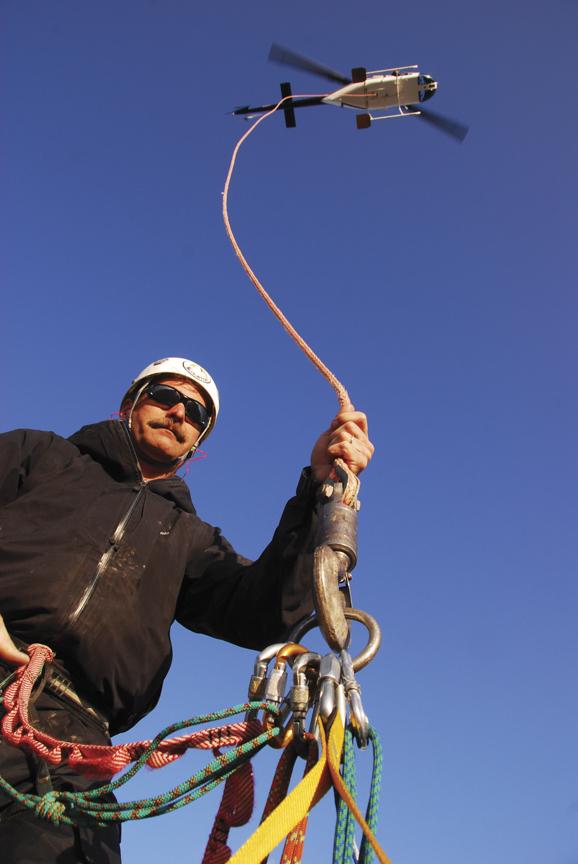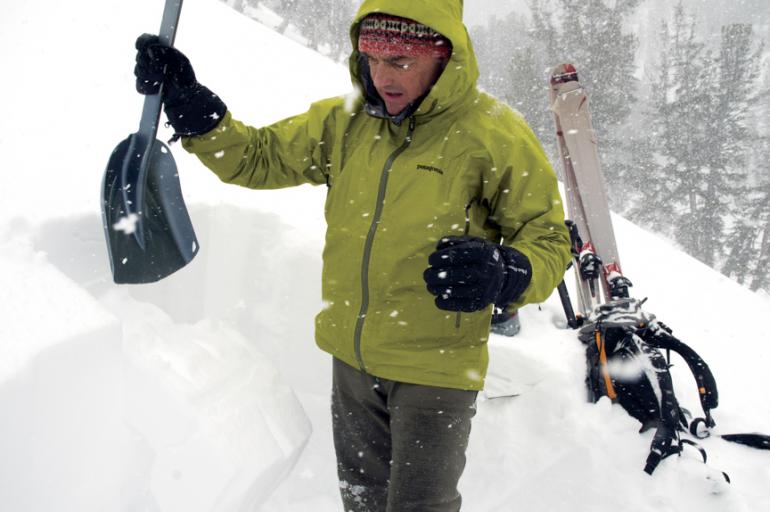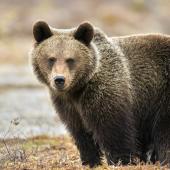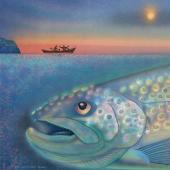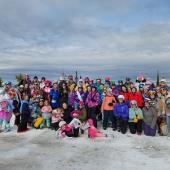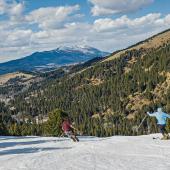Mountain Men
The Dos Equis–hawking character dubbed “the Most Interesting Man in the World” has a rival in Bozeman resident Doug Chabot. The 48-year-old was arrested and jailed for a week by border guards in Tajikistan. He spent a night on an ice platform chopped into a knife-edge ridge at 6,100 meters, his arm clamped against the ridge to keep him from plunging thousands of feet. He consulted with U.S. Special Forces in eastern Afghanistan, where the unit engaged in ferocious battles against Taliban forces. He was served a goat head as the guest of honor in a tiny Afghan village in the “inhospitable” Wakhan Corridor. He has pioneered new climbing routes throughout the world, setting foot on remote summits where no human has previously trod. He has seen the faces of girls in rural Pakistan light up with joy and wonder upon receiving their first schoolbook via the Iqra Fund (“Iqra” is Arabic for “read”), a nonprofit organization he co-founded with his wife Genevieve.
Attempting to chronicle all of Chabot’s life experiences would take forever; for now, we’ll examine the juxtaposition of his “day job” as director of the Gallatin National Forest Avalanche Center (GNFAC) and his volunteer position at Gallatin County Search and Rescue (SAR). Chabot often finds himself in the dichotomous role of both siren-sounder and savior: warning the public about avalanche dangers in the mountains around Bozeman, and then rescuing those who ignore the warnings and find themselves in a crisis situation.
Chabot has a disarmingly deep voice, a ready laugh, and the gift of gab, which makes him a compelling storyteller. He uses these qualities to good effect as director (and therefore spokesman) of the GNFAC; after all, the organization’s mission is about communication and education. He’s more comfortable waxing poetic about snowpack stability and surface hoar than he is about his personal accomplishments, but he agreed to talk with me in the interest of spreading the word about avalanche safety in the Bozeman area.
A New Jersey native who earned a bachelor’s degree in Wilderness Leadership from Prescott College, Chabot is an experienced mountain guide and ski patroller. He started with GNFAC as an avalanche specialist in 1995 and became the center’s director in 2000. Asked about the GNFAC’s primary responsibilities, Chabot reports, “We’re charged with assessing the snow stability in our forecast area and communicating that information to the public in a variety of formats including hot-lines, videos, photos, and online advisories. We also educate the public about avalanche awareness and safety.”
To assess the snowpack in the Bridger, Gallatin, Madison, Lionhead, and Cooke City mountain ranges, Chabot and two other full-time GNFAC avalanche specialists (Eric Knoff and Mark Staples) spend a great deal of time on the move, often putting in 12-hour days. Recent advances in ski and snowmobile equipment translate into increased backcountry access for the public, which means that skiers and snowboarders are carving more and more tracks into previously inaccessible areas. Chabot and his crew make it a point to hit the area’s most popular backcountry destinations, digging snowpits, performing stability tests, making observations, and playing what Chabot calls the “what-if?” game. “The snowpack is dynamic,” Chabot says, “so it forces us to ask questions such as, ‘What will happen if two feet of new snow falls on this slope?’ or ‘What impact would 30 mph winds have on this ridge?’”
Given the number of hours the GNFAC team spends in the backcountry, Chabot believes that his crew looks at more avalanches in a year than most backcountry recreationalists will see in a lifetime. “We spend the bulk of our time where conditions are the worst,” he says. “That also means it’s sometimes the worst skiing you’ll ever find.”
Chabot’s team also plays a key role when tragedy strikes in the backcountry; all three GNFAC employees serve as volunteers on the Gallatin County SAR Hasty Team. Whenever there’s an avalanche-related accident on Forest Service land, members of the GNFAC team are usually the first people on the scene. Their initial responsibility is to assess the conditions and determine if it’s safe for other rescuers. Their second assignment is to help coordinate rescue or body-recovery efforts, and their third duty is to conduct an accident investigation.
Each avalanche accident situation poses a unique set of challenges. Chabot recounts an incident in 2011 where a skier triggered a slide in Frazier Basin in the northern Bridger Mountains and wound up with a broken femur that was considered a life-threatening injury (see page # for the skier’s own account of this incident). Chabot was flown in by helicopter. “It was late afternoon and getting dark,” he explains. “The pilot told me I had only 20 minutes to retrieve the victim and get him on board. Luckily, he was tough as nails and we were able to drag him un-splinted downhill to the landing zone. We took off in the dying light, and that flight likely saved his life.”
Rescue efforts in avalanche country don’t always have such happy endings. “The window for rescue is quite short,” Chabot says. “By the time the rescue team arrives on the scene, chances aren’t good for finding a buried avalanche victim alive.” As a result, the GNFAC team often assists with the grim task of body recovery. Regardless of the outcome, Chabot says investigating a human-triggered avalanche offers significant benefits to the reports and videos that GNFAC issues. “Every incident teaches me something,” Chabot says. “I’ve never walked away without learning something I didn’t know before, and I get to communicate that new knowledge to the public.”
In addition to his service on the Hasty Team, Chabot has served on the Gallatin Valley SAR Alpine Team for the past 22 years. Alpine rescues often involve sketchy, technical terrain, acute injuries, God-awful weather conditions, and frozen nights spent out in the open. SAR Alpine Team supervisor Pat Callis says of Chabot, “With his vast experience in technical alpine climbing, avalanche terrain, and years of adroit service during Alpine, Hasty, and Heli team rescue calls, Doug is exactly the type of person you want coming to your rescue in an alpine environment.”
Chabot knows the value of a well executed rescue; in fact, he once required his own backcountry medical rescue. In 1992, while climbing the 25th pitch of the Nose of El Capitan in Yosemite, Chabot fell 20 feet onto the Camp 5 ledge, breaking his back. Chabot spent 29 hours on the ledge before the local SAR team could execute a vertical raise, followed by a helicopter ride off the summit of El Cap. “I’ve always appreciated the fact that there are well trained people willing to do relatively risky things to help others,” Chabot says.
There are instances, however, when questionable decision-making contributes to the need for a backcountry rescue. Last winter, a Bozeman-based exotic-animal company arranged for a party of paying clients to photograph a snow leopard near Hardscrabble Peak in the Bridger Range. The snow leopard and clients were shuttled via helicopter to the exposed ridge while a winter storm warning—predicting heavy snow in the mountains—was in effect for the area. A hot-wire fence was set up so the photographers could depict the exotic cat in a “natural” mountain setting. Within 45 minutes, the photo shoot had to be abandoned due to a fast-approaching storm. The helicopter pilot could only retrieve four of the ten members of the party before the furious snowstorm engulfed the ridgetop.
Chabot was one of 25 SAR members involved in the search for the storm-stranded men, who reported that they had taken cover in a bowl on the east side of the Bridger Range. Skiing through blizzard conditions at night in avalanche-prone terrain, SAR Alpine team members could find no trace of their quarry. Around midnight, after a fruitless search of nearby basins and gullies, an exhausted Chabot took a catnap in the Sacagawea trailhead latrine while waiting for a fresh team of rescue skiers to arrive, the storm still raging. At 3am, after skiing over a number of fresh avalanche debris piles, Chabot and the SAR team were finally able to determine—by the reflection of the victims’ camera flashes—that the stranded party had unwittingly descended the west side of the mountain range in the whiteout—they were on the opposite side of the Bridgers. Chabot skied back to the trailhead, caught a snowmobile ride to the incident command site, and then was driven back to the SAR Barn. He had spent a total of 15 hours trying to locate and rescue the lost men. At daybreak, the storm had cleared and two helicopters—one from Malmstrom Air Force Base—managed to locate the party of six, load them aboard, and fly them to safety. Later that morning, the same helicopter pilot that flew the snow leopard onto the spine of the Bridgers returned to haul the crated cat via long-line to the airport. All things considered, it turned out that the snow leopard was the least endangered creature involved in the incident.
Occasionally, the lines are blurred between Chabot’s roles as avalanche specialist and rescue squad member. On New Year’s Day 2005, Beaverhead-Deerlodge National Forest staff asked Chabot to investigate an avalanche fatality in the Centennial Mountains. A group of friends had been shredding fresh powder above a backcountry hut in avalanche-prone terrain when they triggered a slab avalanche that killed 24-year-old Blake Morstad and strained his best friend, Sam Kavanagh, through a stand of trees, causing catastrophic damage to his left leg.
When Chabot reached the yurt two days later on skis, he was shocked to learn that there was still a critically injured person at the scene. Nearby SAR teams from Montana and Idaho had been unable to reach the hut due to rough weather, deep snow, and rugged terrain. Switching from “investigator” to “rescuer,” Chabot helped package Kavanagh—who had lost massive amounts of blood—for medical transport aboard a military helicopter. Kavanagh’s lower left leg was eventually amputated, but he was fitted with a prosthetic leg and went on to win a bronze medal in Team Pursuit Cycling at the 2012 Paralympic Games in London.
When the GNFAC advisory warns of “considerable,” “high,” or “extreme” avalanche conditions, the choices skiers and snowmobilers make can create a ripple effect that affects members of the SAR team, including Chabot. On February 24, 2012, GNFAC rated the avalanche danger as “high” in the Bridger Range, meaning that natural- and human-triggered avalanches were very likely. A party of three skiers, each of whom was aware of the high avalanche danger, decided to ski the south summit of Saddle Peak. After dropping in and making a few turns, a female member of the party triggered a massive slide that ran 1,500 feet. When a person is caught in an avalanche of that magnitude, her body is merely another piece of debris in a churning maelstrom of snow, rocks, and timber. Luckily, the female victim wound up only partially buried; her partners were able to dig her out of the snow, and then call for help. She suffered a broken arm, severe contusions on her thigh, and a bashed helmet.
Chabot and Knoff were flown onto the debris pile to administer first aid, package the woman for a helicopter flight off the mountain, and shovel out a landing zone. Once they accomplished those tasks, they conducted a beacon search of the area to determine if additional skiers had been caught in the avalanche. “The snow was still extremely unstable,” Chabot recalls. “Big sections of the slope above us hadn’t slid and I was triggering slides in side gullies as we conducted the search. We were hyper-aware that someone a thousand feet above us could easily trigger a slide that would kill us.”
When skiers, boarders, and snowmobilers make mental calculations about taking risks in the backcountry—including whether to ignore avalanche warnings—shouldn’t they include in those calculations the volunteers who are charged with rescuing them when the snow hits the fan? When Chabot is asked this question, he replies in philosophical terms. “At GNFAC, we don’t ‘open’ or ‘close’ any terrain,” he says. “Our job is to give people information. What they choose to do with that information is up to them. It’s America. We get to choose. Sometimes, our choices wind up being wrong ones; we’ve all made wrong choices. The key is to learn from our mistakes and to share that knowledge with others.”
This winter, as you’re scanning the daily GNFAC avalanche advisory and determining whether it’s safe to rip turns with your crew in the backcountry, consider that the person who issued the advisory might be the same person who’ll risk his or her life to rescue you. And if you happen to be rescued by “the Most Interesting Man in Bozeman,” at least buy him a beer.




